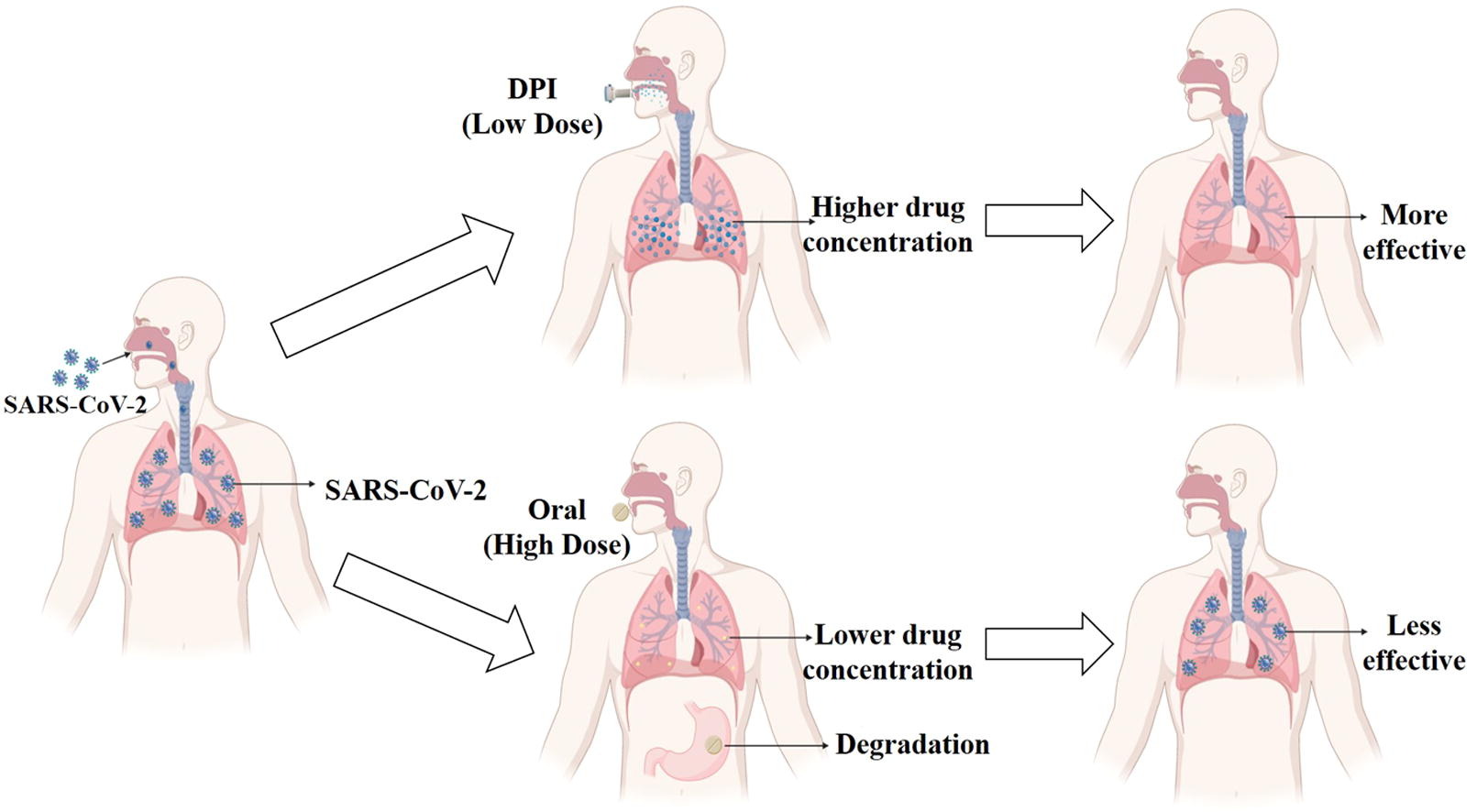Inhaled Therapy for COVID-19: Considerations of Drugs, Formulations and Devices

Severe acute respiratory syndrome coronavirus 2 (SARS-CoV-2), the etiological agent responsible for the COVID-19 pandemic, has outspread at full tilt across the world. Although several effective vaccines continue to be deployed, reliable antiviral treatments have yet to be developed against this disease. Currently, available therapeutics for COVID-19 include repurposed, and a few novel drugs. Many drugs have been promising in preclinical studies, but a majority of these drugs have shown little or no efficacy in clinical studies. One of the major reasons is the insufficient drug concentration in the lung, the primary target site of infection for SARS-CoV-2, from the administration of drugs through oral or intravenous routes. Higher effective doses administered through these routes could also lead to adverse side effects. For this reason, inhaled treatments are being tested as an efficient approach for COVID-19, allowing lower doses of drugs ensuring higher concentrations of the drug(s) in the lung.
Highlights
- • Currently available therapeutics for COVID-19 include repurposed, and a few novel drugs.
- • Current treatments for COVID-19 are mainly given orally or intravenously.
- • The key limitations of these treatments include high oral dose, low efficacy, potential side effects and – more importantly – low drug concentrations at the site of infection.
- • Inhaled treatments ensure higher drug concentration in the target site and avoid unwanted adverse effects as lower doses are required.
- • The rightly chosen cocktail drugs can show better antiviral effects with synergistic activity and lower unwanted drug resistance.
The inhaled treatment combining two or more antiviral drugs will increase potency and reduce the possibility of selecting for SARS-CoV-2 variants with reduced drug susceptibility. Finally, the appropriate drug combination needs to be delivered using a suitable system. Here, we review the current treatment for COVID-19 and their limitations, discussing the advantages of mono and combinational inhaled therapy with a brief outline of the recently reformulated anti-SARS-CoV-2 agents as inhaled formulations. The selection of appropriate delivery devices for inhalation and associated key considerations including the formulation challenges are also discussed.
Inhalable formulation of repurposed anti-SARS-CoV-2 agents
| Drug Name | Formulation | Preparation technique | Excipients used | Delivery device |
|---|---|---|---|---|
| Remdesivir | Dry powder inhaler | Thin-film freezing | Captisol, mannitol, lactose, L-leucine | Plastiape RS00 inhaler |
| Liposomal solution | Film hydration technique and probe supersonic method | SBEβ-CD, DPPC, DSPE-PEG2000, cholesterol, trehalose | Nebulizer | |
| Liposomal solution | Modified hydration technique | DPPC, cholesterol, SBE-β-CD, DOPC | PARI LC PLUS nebulizer | |
| Niclosamide | Dry powder inhaler | Thin-film freezing | Mannitol, leucine | Plastiape RS00 inhaler |
| Niclosamide-lysozyme composite | Dry powder inhaler, nasal spray, and nebulizer solution | Spray-drying, reconstitution | Sucrose, polysorbate 80, histidine, recombinant human lysozyme | Twin Caps inhaler and Aerogen Solo vibrating mesh nebulizer |
| Tamibarotene | Dry powder inhaler | Spray-freeze drying | 2-hydroxypropyl-β-cyclodextrin | Breezhaler |
| Nafamostat mesylate | Inhalable microparticles | Spray-drying | Lecithin, mannitol | Plastiape RS00 inhaler |
| Triazavirin | Solution | Mixing | - | Ultrasonic nebulizer |
| Hydroxychloroquine sulfate | Dry powder inhaler | Air jet milling | - | Osmohaler |
| Isotonic solution | Mixing | - | Aerogen Solo nebulizer | |
| Ivermectin | Solution | Mixing | - | Nebulizer (Micro Cirrus, Berkshire, UK) |
Tushar Saha, Miguel E. Quiñones-Mateu, Shyamal C. Das,
Inhaled Therapy for COVID-19: Considerations of Drugs, Formulations and Devices,
International Journal of Pharmaceutics, 2022, 122042, ISSN 0378-5173,
https://doi.org/10.1016/j.ijpharm.2022.122042.
See also our article
What are the Ingredients and Excipients in the COVID-19 Vaccines?


